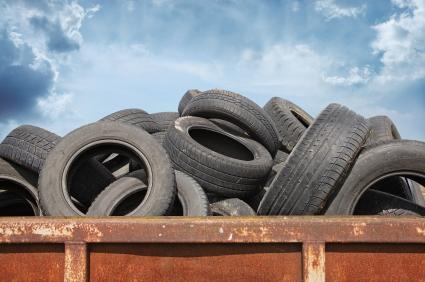Waste and Used Tire Program
Waste and Used Tire Program
Hundreds of tires are illegally dumped every year in San Mateo County. Numerous more are stockpiled at residences. Millions of dollars are spent annually to clean up tires and illegal tire dumps statewide. Your tax dollars and other recycling-based fees pay for city and county personnel to collect dumped tires and place them into the recycling stream.
Additionally, improperly stored tires contribute to the spread of West Nile Virus and in large numbers, cause hard to extinguish and toxic fires.
In 1990, the then California Integrated Waste Management Board (CIWMB) enacted requirements for disposal and storage of waste tires. Beginning July 2003, CIWMB (now CalRecycle) turned over a portion of the program to San Mateo County Environmental Health. The County is responsible for identification, investigation, and enforcement of waste tire generators, haulers, and facilities.
Generators
A waste tire generator is any person, business, or agency that generates more than 10 waste or used tires.
As a generator, you are required to:
- Release waste or used tires only to registered tire haulers, unless 9 or fewer. Tire that are given to unregistered haulers are not tracked and frequently end up dumped illegally. These illegally dumped tires can contribute to the spread of West Nile Virus and tire fires.
- Obtain a free Tire Program Identification Number from CalRecycle. This number must be posted in a conspicuous place.
- Retain copies of the Comprehensive Trip Log (CTL) or Electronic Data Transfer (EDT) receipts on-site for 3 years.
- If fewer than 10 tires are given to unregistered haulers, a log should be kept to track when each tire is removed and to whom it was given.
- Store tires to minimize rainwater collection.
To obtain a TPID number contact CalRecycle at (866) 896-0600.
Haulers
A waste tire hauler is any person who transports ten of more waste or used tires.
As a hauler you are required to:
- Register annually with CalRecycle
- Have a registration decal properly applied to the front passenger side window on the hauling vehicle
- Transport the used or waste tires to a permitted facility, landfill or CalRecycle authorized end use facility
- Post a $10,000 bond
- Have a Comprehensive Trip Log (CTL) receipt in possession while transporting waste or used tires
- Leave a copy of the CTL receipt with the waste generator or end use facility
There are exemptions for haulers that include agricultural purposes and common carriers. Call (650) 372-6200.
Facilities
A waste tire facility is a location which accumulates waste tires for disposal, processing, resale, or storage. Any facility storing 500 or more tires must obtain a permit from CalRecycle and comply with the standards for:
- Fire Prevention
- Site Access
- Site Security
- Vector Control
- Storage
A minor facility is a location that accumulates 500 to 5,000 waste tires. A major facility is a location that accumulates 5,000 or more waste tires.
For more information about permitted tire facilities visit the CalRecycle website.
Households
If you change your own tires or just happen to have a tire or two in your backyard, you can also help prevent the spread of West Nile Virus in your community and ensure proper disposal of your tires.
Tire Storage
To properly store tires keep them out of the rain by placing indoors or under a tarp. (Just be careful the tarp doesn’t collect water). If water does get in the tires, drain the tires as soon as possible. An inch of water can produce thousands of mosquitoes and they can complete their lifecycle in less than a week.
If the tires are used for swings, barriers or running exercises, drill holes in the tires for drainage.
Tire Disposal
When you are ready to get rid of your old tires, they can be taken to one of the places on this list.
Close the Loop: Buy products made from recycled tires such as rubber mats, landscaping bark, bumpers or planters. List of suppliers.
You can also help reduce the problem with waste tires by properly maintaining your tires. Properly maintained tires last longer, resulting in fewer waste tires. For tips on maintaining your tires check the Rubber Manufacturers Association website.
